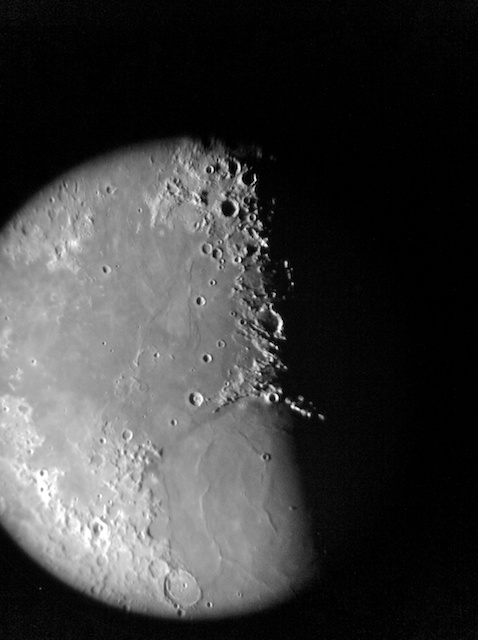
Moon, Delta Scorpii, ISS
Posted: 4 September 2011![[Home!]](../../../../../etx/images/mighty_etx_logo_orig-sm.jpg)
 |
Moon, Delta Scorpii, ISSPosted: 4 September 2011 |
![[Home!]](../../../../../etx/images/mighty_etx_logo_orig-sm.jpg) |
| Follow @mweasner | Welcome | Photos | Videos | Equipment | Links | Data |
Thursday, 1 September, I checked the SkyShed POD dome "dimples"; after one week the dome is looking better. The monsoon weather pattern is coming to an end for this year. There have more cloudy nights this summer than in the previous two summers at Cassiopeia Observatory. Unfortunately, we haven't received much rain with this year's storms. Saturday, 3 September, looked like it could be a good night. Opened the observatory at 1844 MST, 96°F, to mostly clear, but hazy, skies. There were some clouds low in the sky in the west, through north, and to the east.
At 1853 MST, viewed the nearly 1st Quarter Moon at 77X in the 8" LX200-ACF. Delta Scorpii, a bright +2.3 magnitude star, was visible in the FOV. The star was occulted by the moon at some locations, but not for me. It was a nice view however. I set up for lunar imaging with the iPhone 4 using the MX-1 afocal adapter, 26mm eyepiece (77X), visual back. I was able to capture Delta Scorpii (near the bottom of the FOV) using the "Camera" app:

I added the 3X TeleXtender to the 26mm eyepiece and took these iPhone images using the "Camera" app:




Delta Scorpii is visible in the last image.
Beginning at 1913 MST, I did some lunar terminator observing with the 26mm (77X), 15mm (133X), 9.7mm (206X), and 5.5mm (364X) eyepieces. I then updated the ISS TLE in the telescope for the night's pass. Next, I set up for imaging with the D7000 DSLR in preparation for the ISS pass. I took some images of the moon and finished with a test video at 1/2000sec, ISO 3200, at prime focus + 3X TeleXtender. Locked the telescope focus and waited for the pass to begin. At 1954 MST, I noticed that some clouds were now high in the northeastern sky. They would not interfere with the ISS pass, which was west of the meridian, but they would likely mess up my plans for Comet Garradd and DSO imaging later in the night. At 1957 MST, 10 minutes before the ISS pass was to begin, set up to begin tracking.
The pass was a good one. Tracking was fairly accurate. However, due to the fact that it had been a long time since my last ISS imaging attempts, I forgot to check the alignment of the finderscope so I was not certain whether I actually captured the ISS in the video recording. I never saw the ISS on the DSLR screen during the pass. Post-pass, I checked the finderscope alignment. It was close but not perfect. I aligned it to the DSLR view at prime focus + 3X TeleXtender using the star Arcturus, so it will be ready for the next ISS imaging attempt. During post-processing of the video, several frames had the ISS in the FOV. However, at 1/2000sec, ISO 3200, the image was severely underexposed and no details were visible. Here is one example image, cropped from the full-frame HD video, and edited to at least show the ISS:

The central core of the station is all that is visible. Some frames had a hint of the solar panels. I will bump up the ISO to 6400 for the next attempt but will stick with a shutter speed of 1/2000sec.
At 2032 MST, the clouds had now reached the zenith. I slewed the telescope to Comet C/2009 P1 Garradd; it was just barely visible at 77X due to the clouds and moon. M101 was covered by clouds so I could not observe the supernova in the galaxy. I decided to close the observatory.
The observatory dome was closed at 2045 MST, 81°F. Just as I was preparing to leave the observatory, I saw this praying mantis along the red rope lighting on the floor of the POD:

I have posted a review of Southern Stars "SkySafari Pro for Mac OS X". Check it out.
Go to the previous report.
Return to the Cassiopeia Observatory Welcome Page.